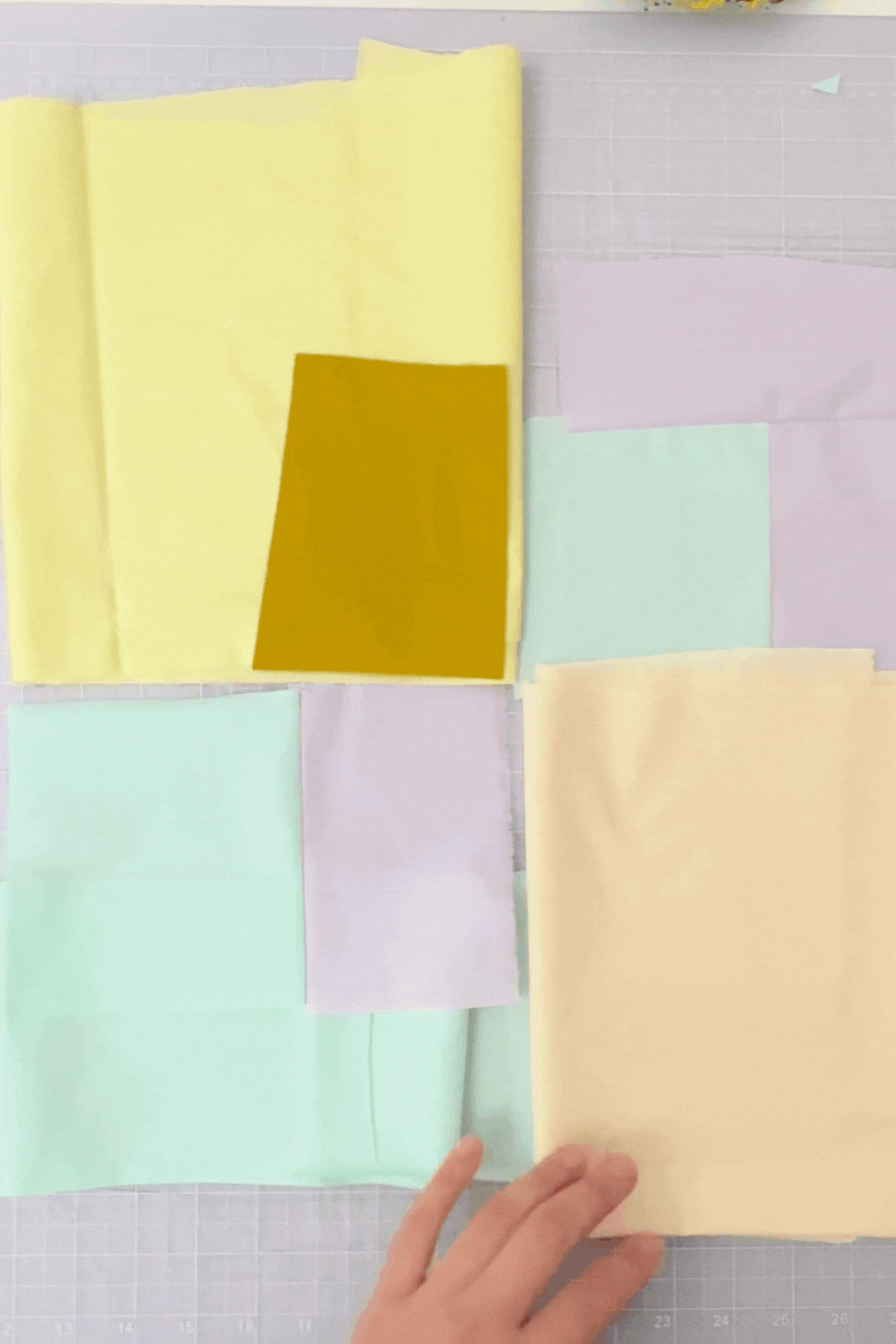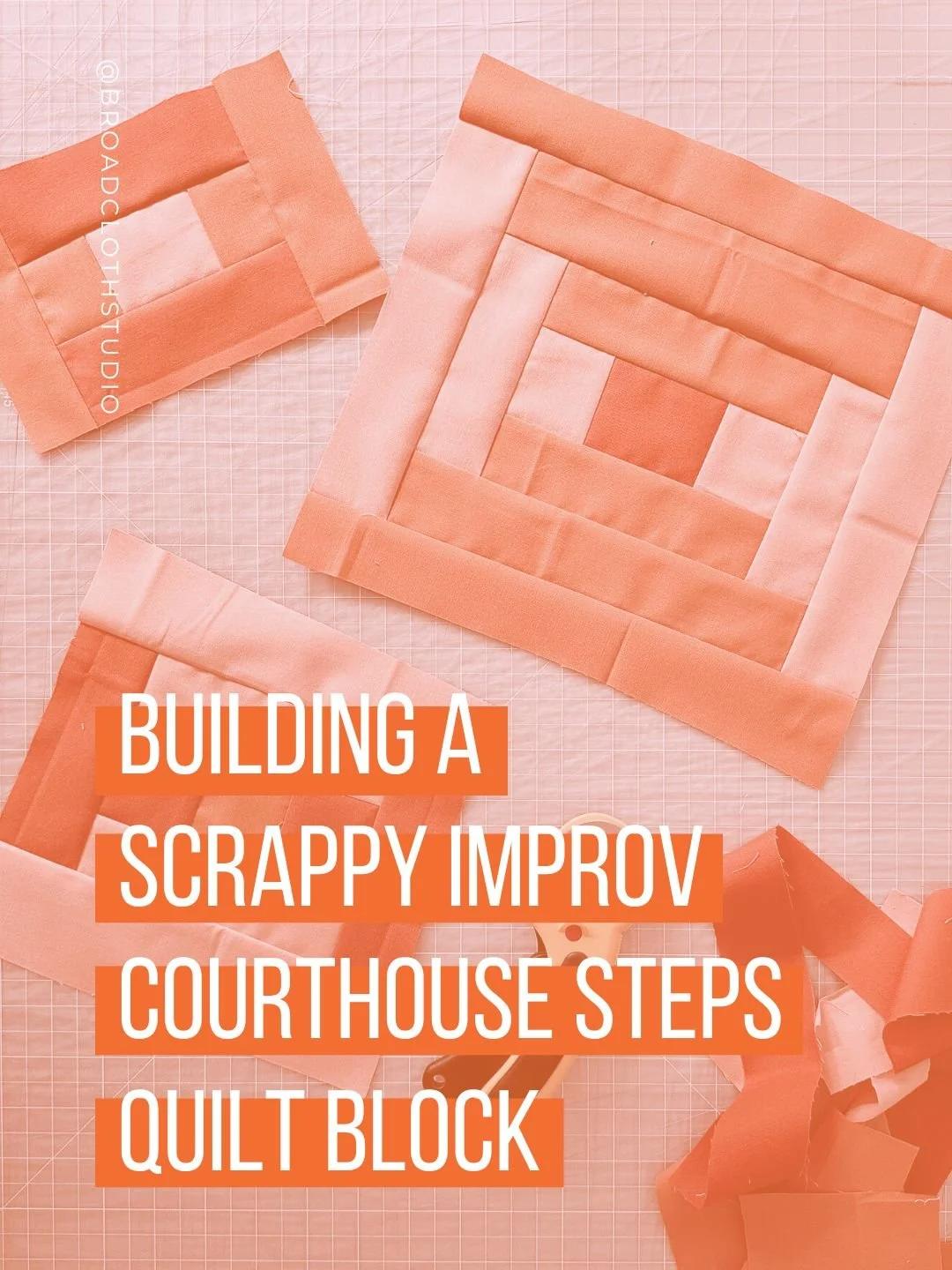Squares Askew Remix: A Structured Improv Exercise
You know that free mini quilt pattern you get when you sign up for the newsletter? The Squares Askew design? If you’re wondering how to start an improv quilt, Squares Askew is a perfect place to begin. This bite-sized project balances structure with freedom, making it ideal for learning the art of quilting with constraints. It’s full of playful energy and a perfect starting point for your first improv quilting experiment.
This structured improv quilting prompt invites you to un-measure, loosen the layout, and let instinct guide the process. It’s not chaos — it’s creativity with constraints. The exercises and prompts below will help you explore how to use creative limits to foster your own unique quilting style.
Start with Structure, End with Play
At first glance, the Squares Askew mini quilt looks like a neat little composition: four tidy quadrants, each one built from the center out in a quarter-cabin log-cabin-quilt-block-style layout. But here’s the secret: this structure is flexible. It’s stable enough to hold a shape, yet loose enough to bend.
That’s what makes it ideal for improv piecing. You’re not starting from chaos. You’re starting from something familiar, and then breaking the rules, one cut at a time.
If you’ve ever wondered how to start an improv quilt without getting overwhelmed, this is your soft landing. You already have a framework to build on, now it’s time to stretch it in new and playful ways. Here are five prompts to help you explore, experiment, and make the pattern your own.
5 Structured Improv Quilting Prompts
If you're unsure how far to veer off course, here are some ways to riff while still honoring the underlying framework:
1. Start Without a Ruler
Begin by making one quadrant without measuring. Put the ruler down and let your rotary cutter move by instinct. Let each log respond to the one before it: thinner, chunkier, slanted, or short. Stop when your quadrant finishes at around 11½" square. You are building a conversation in fabric, one round at a time. The goal is not perfection; it is energy.
2. Change the Number of Logs
The original design uses a single center “hearth” and three surrounding rounds of logs in each quadrant, but that’s just a starting point. Try building each block with just the hearth and one round for a bold, minimalist vibe. Or mix it up: one round here, two there, maybe all three in just one quadrant. This kind of variation adds rhythm and surprise. Just be sure your final blocks finish 11½" square so you can assemble the mini quilt without a hitch. Let each section bring its own energy.
3. Flip, Rotate, and Embrace Asymmetry
The original layout has each hearth pointing inward toward the center. But you don’t have to stick to that. Try rotating one block 180°, so its hearth lands in a corner of the mini quilt. Do it with two opposite blocks, all four, or any combination you like. Even that small change can shift the whole composition, just enough to make the layout feel fresh, offbeat, and a little more your own.
4. Add in a Stripe
Sneak in a striped log — just one. Use it in place of a regular log anywhere in the block. The directional lines will pull the eye and throw off the balance just enough to make the block feel a little unfinished, a little off-kilter, in the best way. It’s a small disruption that adds energy, tension, and a wink of improv to the structure.
5. Throw in a Triangle
Swap out the center “hearth” for a half rectangle triangle (HRT), or use one in place of a log (or two!). The elongated diagonal will immediately shift the energy of the block, pulling the eye in a new direction and breaking the usual flow. It’s a subtle way to introduce movement and asymmetry without abandoning the overall structure.
Visualize Before You Cut
Hesitant to cut into your fabric? Start by sketching, collaging, or mock-building your ideas. Print the coloring sheet that comes with the pattern and test out some of the prompts: try exaggerating a log, dropping one, or adding a triangle. Color over the lines to play with scale or composition. Nothing’s off-limits.
Prefer something more tactile? Fold up scraps or yardage and layer them to mimic the pattern layout. Or cut shapes from paper and collage a few block variations. It’s a low-stakes way to explore your ideas before the rotary cutter comes out, a gentle warm-up before the real improv begins.
Document Your Process
Record your block as it comes together. You can film from above or take a photo at each step. Try talking through your decisions as you go. What made you reach for that fabric? Why did you trim there? What felt finished, and what didn’t?
Speaking your thoughts out loud helps you understand your own instincts. It makes the invisible parts of your process visible. When you look back, you may start to notice patterns in how you work and how your ideas take shape.
The value isn’t just in capturing the process. It’s in returning to it. Improv isn’t only about instinct. It’s also about awareness.
Share Your Remix
If you try any of these prompts, I’d love to see what you make. You don’t have to wait until it’s finished. Share a block in progress, a layout you’re testing, or a moment that surprised you. Tag your project with #SquaresAskewQuilt and #SquaresAskewRemix, and please tag me @broadclothstudio so I don’t miss it.
Remember: sharing isn’t just about showing what you made. It’s a record of your process, what you noticed, what you tried, what you felt your way through. And your version might be the quiet encouragement someone else needs to begin.
Ready to Go Deeper into Improv Quilting?
If this sparked something for you, you might enjoy the Imperfect Patchwork Playbooks — a series of guided exercises designed to help you explore layout, rhythm, scale, and shape in your own way.
A great place to start is the L-Shape Studies Playbook, which pushes further into the ideas explored above, helping you experiment more deeply with block shapes and dynamic layouts.
All the playbooks provide creative scaffolding for improv quilting. Not rigid, but rooted. A place to begin, not a set of rules to follow.
Explore the full series here.
















